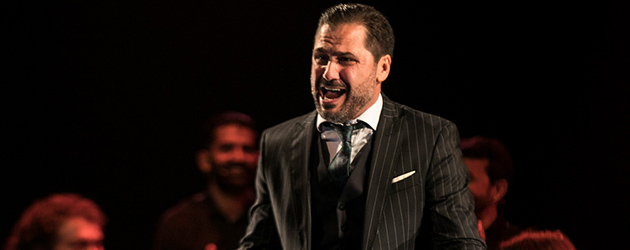Text: Estela Zatania
Photos: Ana Palma
David Carpio «Con la voz en la tierra»
Daniel Doña Compañía de Danza Española
«No Pausa»
Wednesday, March 7th, 2018. Jerez de la Frontera
CON LA VOZ EN LA TIERRA.
Sala Paúl, 7:00pm. Voice: David Carpio. Guitar: Santiago Lara, Diego del Morao. Percussion: Carlos Merino. Rhythm: Chicharito, Carlos Grilo, Diego Montoya, Javier Peña and Marce. Guest artists: Manuel Valencia (guitar), Pablo Martín (upright bass) and Diego Villegas (harmonica).
It’s like these slot machines, you pull the lever and hope to see the prize come up. Last night, the two scheduled programs of the Festival de Jerez gave the “prize” of both being excellent theater experiences in very different formats and content.
First, young singer David Carpio, whom we saw and reviewed at the Nimes Festival a little over a month ago when I wrote “the high quality of this upcoming singer is a personal triumph no one can question”, last night made it clear he’s come to occupy his place within the panorama, the difficult panorama of classic flamenco singing. He came to present his new recording, “Con la Voz en la Tierra”, but if others treat a presentation of this sort as a publicity exercise, David put all the responsibility and interest required by a recital or show with no associated product for sale.
He delivers strictly classic cante, always looking for fresh perspectives with the help, as he pointed out, of David Lagos, “a maestro with his ideas”. The romance form he used to open, accompanied by aggressive 3-beat percussion, immediately gave a rock feel, without detracting at all from the interpretation. That first cante already triggered a warm ovation from the audience.
Seated, and with the guitar accompaniment of Santiago Lara, who also produced the record, he sang tarantas. Flamenco fans always talk about “chewing” the singing. David goes beyond that; he chews it, melts it down, soaks it in dry sherry and chews it some more, until he squeezes out all the possibilities. His is a beautiful flamenco voice, sweet and acrid at the same time, with that one thing so difficult to achieve: personality.
A mix of milonga and bambera (sounds weird, doesn’t it…but it works), is lovely as well as moving, with Diego Villegas playing harmonica. Tangos del Piyayo is accompanied by bassist Pablo Martín, with a certain Argentine feel. David Carpio cultivates an admirably wide repertoire. Soleá apolá, again with the bassist, is a very interesting combination, and this man from the Plazuela of Jerez dares to sing Pepe Marchena, and it comes out just fine because he does it with the greatest affection, and the audience accepts it all.
The bulería dedicated to, and about Moraíto, authored by David and Alfredo Lagos, is an emotional journey accompanied by the guitar of Diego del Morao himself. Following this, it’s the perfect moment for siguiriyas, a cante that identifies Jerez, with the accompaniment of Manuel Valencia whose guitar sounds both of past and future, and which David interprets with genuine intensity, no histrionics here.
From free-form fandangos, he navigates easily towards Huelva, and then more bulerías (we are in Jerez after all), and just when you’re feeling the satisfaction of having enjoyed a well-rounded show, dancer Manuel Liñán appears on stage with his non-stop bulerías excitement.
When the effusive applause finally subsides, David is left alone with his martinete, and you know this interpreter is destined for important things.
DANIEL DOÑA COMPAÑÍA DE DANZA ESPAÑOLA
“NO PAUSA”
Teatro Villamarta, 9:00pm
Dancers: Daniel Doña, Cristina Gómez, Soujung Youn, Cristian Martín. Guitar: Francisco Vinuesa. Voice: David Vázquez.
Another fresh perspective, but on Spanish dance and its relationship with flamenco. Daniel Doña, head of the company, dancer, director and choreographer, the day before at the press conference said that “the important thing is the dancing”, and straightaway you want to thank him for freeing us from impenetrable dark concepts, leaving us free to enjoy a finely crafted product without unnecessary ado. And so we did. I did. Four dancers to interpret the various styles of Spanish dance. But even that is excess intellectual baggage. The important thing is that the members of the company are well-prepared talented professionals, the choreographies are original and at times surprising, and nothing was missing or excessive. A perfect jewel, like exquisite ceramic ballet dancers in a music box, and triggering the same sort of fascination.
Castanets without complexes, Spanish dance of slipper and shoe as it was popularized in Europe in the 19th century, modern dance without overdosing and, strangely enough, more flamenco than in some presumably flamenco shows. You feel the connection with the bolero school, Spanish folklore and flamenco, a continuous give and take, push and pull that would eventually give birth to flamenco dance more or less as we know it today.
Singer David Vázquez manages a complicated repertoire of mining songs, zorongo (a small masterwork), threshing songs (a choreographic miracle), abandolao with bolero (delightful) and petenera (original and archaic at the same time), with the guitar of Francisco Vinuesa.
The “fiesta finale” was the representation of a folkloric verdiales group, with lighting effects, leaving the audience happy and smiling, having been able to glimpse what flamenco was like right before it lost its innocence.
